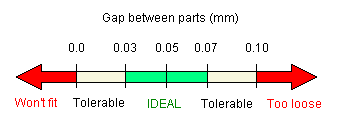As we said earlier, the ideal clearance will be 0.05mm, but if the gap is in the range 0.03mm to 0.07mm, then the assembly will still function as desired. Any assembly which meets this criterion will be accepted as ideal. As the gap decreases towards zero, the performance of the finished unit will worsen. To keep things reasonably simple, we shall assume that any assembly which will actually fit together will be accepted. Therefore, if the gap is less than 0.03mm but greater than 0.00mm, the assembly will be accepted, but will not be ideal. Similarly, if the gap exceeds 0.07mm the performance will not be ideal, and if it exceeds 0.10mm then the final unit will be too loose, and will cause problems further downstream. The image below shows the possible outcome if a randomly selected shaft, and a randomly selected bearing are assembled together. In this example, only those assemblies which will not fit together at all will be reworked. Any other combination, no matter how tight or loose will be accepted.  It's important to note here that we are having to make a lot of assumptions that would not be possible in a real world situation. For example, we are assuming that:
|